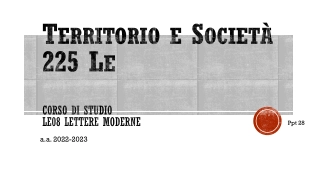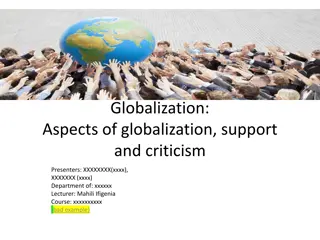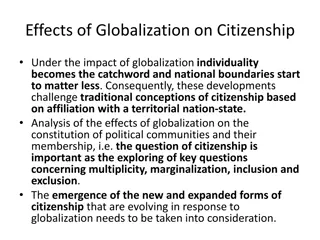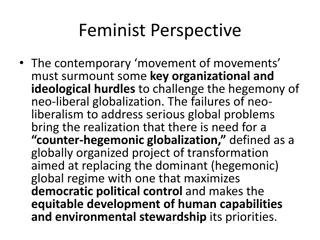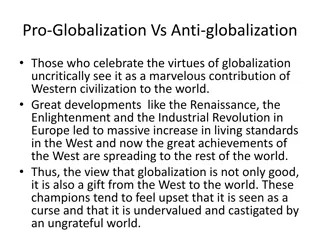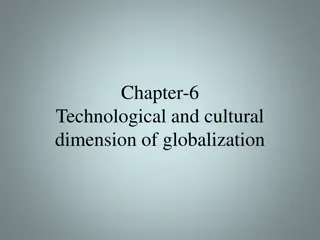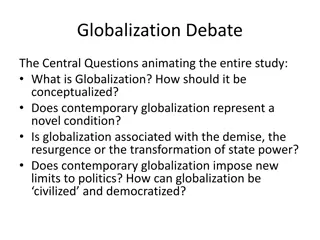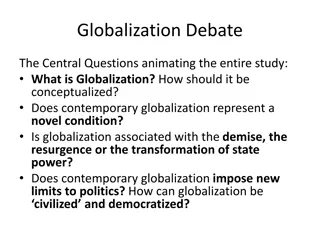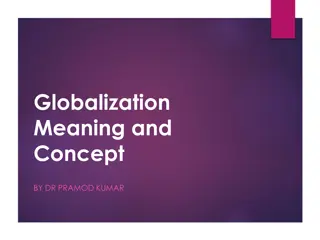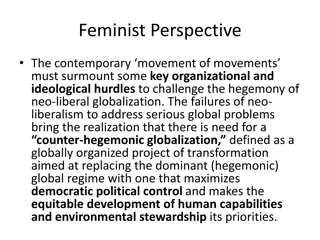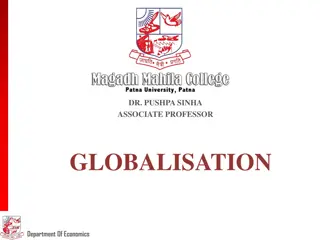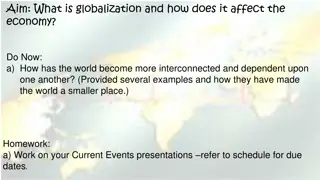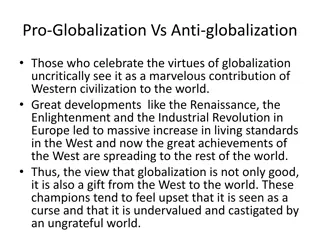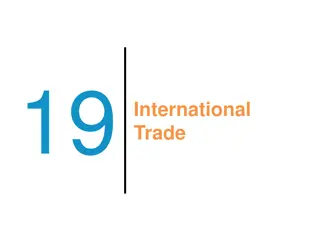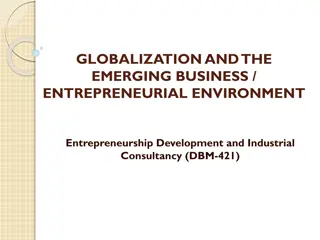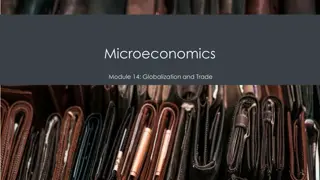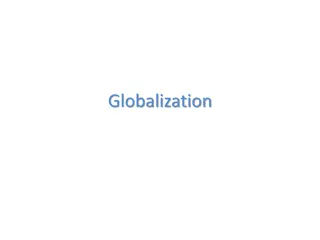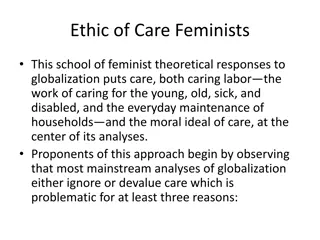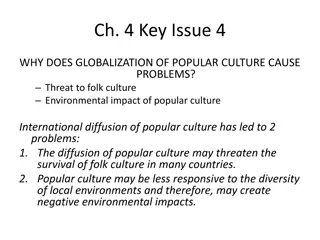Understanding Globalization's Impact on Developing Countries
Economic globalization, characterized by increased integration of economies, presents both opportunities and challenges for developing nations. While it offers benefits like knowledge transfer and trade growth, it can also exacerbate inequalities and environmental degradation. Globalization raises questions on trade's role in economic development and income distribution, especially for less developed countries. The debate between outward and inward-looking trade policies further complicates the landscape.
Download Presentation

Please find below an Image/Link to download the presentation.
The content on the website is provided AS IS for your information and personal use only. It may not be sold, licensed, or shared on other websites without obtaining consent from the author. Download presentation by click this link. If you encounter any issues during the download, it is possible that the publisher has removed the file from their server.
E N D
Presentation Transcript
Chapter-Five International Trade Theory and Economic Development Strategy
Economic Globalization: An Introduction Globalization -the increasing integration of national economies into expanding international markets. Globalization is a process by which the economies of the world become more integrated, leading to a global economy and, increasingly, global example, through international agencies such as the world trade organization (wto). Globalization - refers to an emerging global culture, in which people consume similar goods and services across countries and use a common language of business, English. In its core economic meaning, globalization refers to the increased openness of economies to international trade, financial flows, and direct foreign investment. economic policymaking, for
Impact of globalization GLOBALIZATION can in many ways have a greater impact in developing countries: For some people, the term globalization suggests exciting business opportunities, efficiency gains from trade, more rapid growth of knowledge and innovation, and the transfer of such knowledge to developing countries facilitating faster growth, or the prospect of a world too interdependent to engage in war. For other people, however, globalization raises disturbing concerns: that inequalities may be accentuated both across and within countries, that environmental degradation may be accelerated, that the international dominance of the richest countries may be expanded and locked in, and that some peoples and regions may be left further behind. 1. 2.
DCs or LDCs is more benefited/victimized? Globalization carries benefits and opportunities as well as costs and risks for all peoples in all countries: However, The potential benefit is greatest for developing countries. Why? Globalization can potentially benefit poor countries directly and indirectly through cultural, social, exchanges, as well as through conventional trade and finance. There is a fastest diffusion of productive ideas -developing countries catch up more quickly. The potential downside/disadvantage of globalization is also greater for poorer countries. Why? Sometimes they become locked into a pattern of dependence If dualism within developing countries sharpens Some of the poor are entirely bypassed by globalization scientific, and technological
Five Basic Questions about Trade and Development How does international trade affect economic growth? How does trade alter the distribution of income? How can trade promote development? Can LDCs determine how much they trade? Is an outward-looking or an inward-looking trade policy best?
International Trade: Some Key Issues Many developing countries depends heavily on exports of primary products which is mainly affected by uncertainty-B/c prices of primary products fluctuate downward, as well as very volatile Many developing countries also depends on the importation of raw materials (such as machinery, capital goods, intermediate producer goods, and consumer products) Majority of developing nations, import demands exceeded their capacity to generate sufficient revenues from the sale of exports. This led to that many developing countries have chronic deficits on current and capital accounts which depletes their reserves, causes currency economic growth. Recently many developing countries sought to promote exports and accumulate large foreign exchange reserves to cushion against crises - spurring new policy debates risks and instability, and may slow
International trade and economic development Why do people trade? Because it is profitable to do so. Why? B/Cs Different people possess different abilities and resources and may want to consume goods in different proportions. Individuals or families unable consumption requirements even for the simplest life to provide themselves with all the Diverse preferences as well as varied physical and financial endowments open up the possibility of profitable trade. Individuals usually find it profitable to engage in the activities for which they have a comparative advantage in terms of their natural abilities or resource endowments. Comparative advantage: it is production of a commodity at a lower opportunity cost than any of the alternative commodities that could be produced.
Principle of comparative advantage The concept of relative cost and price differences is basic to the theory of international trade. The principle of comparative advantage, is that a country should, specialize in the export of the products that it can produce at the lowest relative cost. Comparative advantage differences in the productivity of labor between countries cause productive differences, leading to gains from trade. (Ricardian model) says The Ricardian model uses the concepts of opportunity cost and comparative advantage. The opportunity cost of producing something measures the cost of not being able to produce something else because resources have already been used.
Principle of comparative advantage opportunity costs A country faces opportunity costs when it employs resources to produce goods and services. For example, a limited number of workers could be employed to produce either Samsung Mobile or computers. The opportunity cost of producing computers is the amount of Samsung mobile not produced. The opportunity cost of producing Samsung mobile is the amount of computers not produced. A country faces a trade off: how many computers or Samsung mobile should it produce with the limited resources that it has?
Principle of comparative advantage opportunity costs Example: Suppose that in Kenya 10 million Samsung mobile could be produced with the same resources that could produce 100,000 computers. Suppose that in Ethiopia 10 million Samsung mobile could be produced with the same resources that could produce 30,000 computers. Workers in Ethiopia would be less productive than those in Kenya in manufacturing computers. Quick quiz: what is the opportunity cost for Ethiopia if it decides to produce Samsung mobile? Ethiopia has a lower opportunity cost of producing Samsung mobile as compared to Kenya.
Principle of comparative advantage opportunity costs Kenya has a lower opportunity cost of producing computers. B/Cs Ethiopia can produce 30,000 computers, compared to 10 million Samsung mobile that it could otherwise produce. The Kenya can produce 100,000 computers, compared to 10 million Samsung mobile that it could otherwise produce. The Kenya can produce 30,000 computers, compared to 3.3 million Samsung mobile that it could otherwise produce. A country has a comparative advantage in producing a good if the opportunity cost of producing that good is lower in the country than it is in other countries. A country with a comparative advantage in producing a good uses its resources most efficiently when it produces that good compared to producing other goods.
Principle of comparative advantage opportunity costs Suppose initially that Ethiopia produces computers and the Kenya produces Samsung mobile, and that both countries want to consume computers and Samsung mobile. Can both countries be made better off? NO. B/Cs o Initially both countries could only consume 10 million Samsung mobile and 30 thousand computers. If they produce goods in which they had a comparative advantage, they could still consume 10 million Samsung Mobile, but could consume 100,000 30,000 = 70,000 more computers.
Relative factor endowments and international specialization Relative factor endowment (Heckscher-Ohlin model) says differences in labor, labor skills, physical capital, land, or other factors of production between differences, leading to gains from trade. countries cause productive Factor endowment trade theory of neoclassical model of free trade postulates that countries will tend to specialize in the production of the commodities that make use of their abundant factors of production (land, labor, capital, etc.). The basis for trade arises because countries are endowed with different factor supplies, not because of inherent technological differences in labor productivity for different commodities between different countries
Relative factor endowments and international specialization Given the divergent relative factor endowments, relative factor prices will differ (e.g., labor will be relatively cheap in labor- abundant countries and capital will be relatively cheap in capital- abundant countries). So Countries with cheap labor will have a relative cost and price advantage over countries with relatively expensive labor in commodities that make intensive use of labor (e.g., primary products). They should therefore focus on the production of these labor-intensive products and export the surplus in return for imports of capita intensive goods. Conversely, countries well endowed with capital will have a relative cost and price advantage in the production of manufactured goods, which tend to require relatively large inputs of capital compared with labor.
Relative factor endowments and international specialization To summarize, the factor endowment theory is based on two crucial propositions: 1. Different products require productive factors in different relative proportions. For example, agricultural products generally require relatively greater proportions of labor per unit of capital than manufactured goods, which require more machine time (capital) per worker than most primary products. In two commodity (X, Y), two factor world (L, K), we say commodity Y is capital intensive if K/L ratio for Y is greater than K/L ratio for X 2. Countries have different endowments of factors of production (land, and capital). Developed countries are relatively capital-abundant, while most developing countries are labor-abundant. Therefore: Each country will export items whose production requires intensive use of the factors with which it is abundantly endowed relative to other nations. Conversely, each country will import goods whose production requires intensive use of factors that are relatively scarce.
International trade & economic development main conclusions of neoclassical model Trade is an important stimulator of economic growth. It enlarges a country s consumption capacities, increases world output, and provides access to scarce resources and worldwide markets for products without which poor countries would be unable to grow - All countries gain from trade & World output increases with trade 2. Trade tends to promote greater international and domestic equality by equalizing factor prices, raising real incomes of trading countries, and making efficient use of each nation s and the world s resource endowments (e.g., raising relative wages in labor-abundant countries and lowering them in labor-scarce countries). 3. Trade helps countries achieve development by promoting and rewarding the sectors of the economy where individual countries possess a comparative advantage, whether in terms of labor efficiency or factor endowments. It also lets them take advantage of economies of scale. 1.
International trade & economic development main conclusions of neoclassical model 4. In a world of free trade, international prices and costs of production determine how much a country should trade in order to maximize its national welfare. Countries should follow the principle of comparative advantage and not try to interfere with the free workings of the market through government policies that either promote exports or restrict imports. 5. Finally, to promote growth and development, an outward-looking international policy is required. In all cases, self-reliance based on partial or complete isolation is asserted to be economically inferior to participation in a world of unlimited free trade.
The trade policy debate and industrialization Trade Optimists and Trade Pessimists: There are major issues and arguments in the great debate between advocates of free-trade, outward-looking development and export promotion policies the trade optimists and advocates of greater protection, more inward-looking substitution the trade pessimist. Trade pessimists are the theorists who argue that without tariff protection or quantitative restrictions on trade, developing countries gain little or nothing from an export-oriented, open-economy posture. Trade pessimists tend to focus on four basic themes (distinct ideas): 1. The limited growth of world demand for primary exports 2. The secular deterioration in the terms of trade for primary producing nations 3. The rise of new protectionism against manufactured and processed agricultural goods from developing countries, and 4. The presence of market failures that reduce the ability of developing countries to move up to export higher-value products. strategies, and greater import
Trade Pessimists The value of traditional developing-country exports to developed countries grow slowly because of: A shift in developed countries from low technology, material-intensive goods to high- 1. technology, skill-intensive products, which decreases the demand for raw materials from developing country. Increased efficiency in industrial uses of raw materials-less dd for additional inputs 2. The substitution of synthetics (artificial inputs) for natural raw materials like rubber, 3. copper, and cotton The low income elasticity of demand for primary products and light manufactured 4. goods as income of developed country increase, dd for primary product not increase by the same extents. The rising productivity of agriculture in developed countries- DCs reduces the 5. imported agricultural products, Relatively higher levels of protectionism for both agriculture and labor-intensive 6. developed country industries.
Trade Pessimists The terms of trade remain unfavorable or continue to deteriorate because of: Oligopolistic control of factor and commodity markets in developed countries combined competitive sources of supply of a developing country s exportable A generally lower level of the income elasticity of demand for its exports - as income of developed country increase - demand for primary product may not increase as such. 1. with increasing 2.
Trade Pessimists Trade pessimists therefore conclude that trade opportunities are limited and even hurt developing countries for four reasons: The slow growth in demand for their traditional exports means that export expansion results in lower export prices and a transfer of income from poor to rich nations. Without import restrictions, the high elasticity of developing countries demand for imports combined with the low elasticity for their exports means that developing countries must grow slowly to avoid chronic balance of payments and foreign-exchange crises; Developing nations have their static comparative advantage in primary products, which means that export-promoting free-trade policies tend to inhibit industrialization, which is in turn the major vehicle for the accumulation of technical skills and entrepreneurial talents. Trade pessimists view trade liberalization under the WTO as limited in practice, with developing economies particularly the least developed countries lacking the high-powered lawyers and other resources needed to pry developed markets open. a. b. c. d.
Trade optimists Trade optimists are the theorists who believe in the benefits of free trade, open economies, and outward-looking development policies. Trade optimists tend to focus the role of international demand in determining the gains from trade. They argue that trade liberalization promotion, currency devaluation, restrictions, and generally getting prices right ) generates rapid export and economic growth because free trade provides a number of benefits: 1. It promotes competition, improved resource allocation, and economies of scale in areas where developing countries have a comparative advantage. Costs of production are consequently lowered. 2. It generates pressures for increased efficiencies, product improvement, and technical change, thus raising factor productivity and further lowering costs of production. (including removal export trade of
Trade optimists 3. It accelerates overall economic growth, which raises profits and promotes greater saving and investment and thus furthers growth. 4. It attracts foreign capital and expertise, which are in scarce supply in most developing countries. 5. It generates needed foreign exchange that can be used to import food if the agricultural sector lags behind or suffers droughts or other natural catastrophes. 6. It eliminates costly economic distortions caused by government interventions in both the export and foreign-exchange markets and substitutes market allocation for the corruption and rent- seeking activities that typically result from an overactive government sector. 7. It promotes more equal access to scarce resources, which improves overall resource allocation. 8. It enables developing countries to take full advantage of reforms under the WTO.
International Trade Strategies for Development: Export Promotion versus Import Substitution Two basic strategies regarding trade have been adopted through history: 1. Inward-looking development policies (import substitution ): These policies stress economic self-reliance on the part of developing countries including domestic development of technology, the imposition of barriers to imports, and the discouragement of private foreign investment. Import substitution industrialization policy aims the replacement of imported goods by goods produced domestically; via protection of domestic markets against imports. It is a deliberate effort to replace consumer imports by promoting the emergence and expansion of domestic industries.
Inward-looking development policies (import substitution ) The basic idea is the following: There may be high initial costs of local production So, in order to make it profitable for local entrepreneurs to invest, protective barriers are raised to reduce the influx /inflow of imports This increases the market for potential local producers and increases their profitability How are these protective barriers practiced? The government uses instruments such as tariffs or quotas on imports, sometimes ban on imports of certain goods, subsidies to the inputs of the local producers But why should the government protect some industries? B/Cs If local firms have high costs of production, they shouldn t produce at all since they unable to compete with imported goods produced at lower cost in abroad. So it would be better for the economy to import these goods. But there are some situations where initial costs are high, but tend to decrease once industry develops. In these cases, it may be interesting for society to protect local industries in the first stages, in order to take advantage of the higher productivity that will ensue in the future, and reducing cost of production in the long-run.
Inward-looking development policies (import substitution ) This idea tells that industries should be protected in the first stages of their development is called the Infant Industry argument, and it s associated with German economist Friedrich Liszt. New industry in a country has to compete against firms abroad, that have long experience with the same production technology, with marketing strategies, distribution channels, etc. So these new national industry needs time to learn the best way to operate on all these dimensions.
Inward-looking development policies (import substitution ) Note that there is a cost of industry protection to society as a whole. Every consumer has to pay a higher price for the good, and possibly 1. consume less, in order for a single firm to be protected these welfare costs can be very high Discussions in these area are always very political: producers will 2. always try to convince the government and society that their sector has to be protected, in order for the industry to develop, for jobs to be generated and etc We usually see lots of industries being protected for long periods of 3. time, when it would be very hard to find any economic reason to justify such long term protection
Inward-looking development policies (import substitution ) This is similar to the danger of political capture of the government that can be discussed in the context of industrial policies. Internal producers may be able to influence the government (well- connected or bribes) in order to maintain the protection, even when it s not socially desirable anymore. In reality, this was probably the main reason behind the failure of the historical experiences of import substitutions: after the initial growth of industries, when the most of the learning was over, governments were not politically able to reduce industrialists, unions, etc). trade barriers (pressures from
Trade Policy Instruments Protective Tariffs A protective tariff works like a tax on imported goods: if you re an importer, you have to pay a fraction of the imported good price as a tax to the government The basic effect of a tariff is to raise the domestic price above the world price In a competitive market, with no tariffs, the world price of any good would be close to the price observed in each country; the only difference in prices between countries would be due to transportation costs The tariff will increase domestic producers welfare because it ll allow them to sell more at a higher prices It will reduce domestic consumers welfare because they ll consume less at a higher price. Additionally, it will tend to reduce the efficiency of the economy (at least in short run), because resources will be diverted into production in the import substitution sector, when they d be more productive if used elsewhere.
Impact of tariff In the closed of economy home the and equilibrium quantity would be P1 and Q1. If this country were then to open its economy to world trade, its small size in relation to the world market would mean that it would face a horizontal, perfectly elastic demand curve. In other words, it could sell (or buy) all it wanted at a lower world price, P2. Domestic consumers would benefit from the lower price of imports and the resultant purchased, while domestic producers and their employees would clearly suffer as they lose business to lower- cost foreign suppliers. price greater quantity
Impact of tariff Thus at the lower world price, P2, the quantity demanded rises from Q1 to Q3, whereas the quantity domestic producers falls from Q1 to Q2. The difference between what domestic producers willing to supply at the lower P2 world price (Q2) and what consumers want to buy (Q3) is the amount that will be imported - shown as line ab in this figure supplied by are
Impact of tariff Facing domestic production and jobs as a result of free trade and desiring to obtain infant -industry protection, local producers will seek tariff relief from the government. The effects of a tariff (equal to t0) are shown in the lower half of the following tables. The tariff causes the domestic price of shoes to rise from P2 to Pt that is, Pt = P2 (1 + t0). Local consumers now have to pay the higher price and will reduce their quantity demanded from Q3 to Q5. the potential loss of
Impact of tariff Domestic now (and employment) up to quantity Q4 from Q2. The rectangular area cdfe measures the amount of the tariff revenue collected by the government imported shoes. producers expand can production on
Trade Policy Instruments Import Quotas Quotas are quantitative restrictions: the government fixes the maximum quantity of a good that can be imported In principle, we could think that quotas would have the same effects of corresponding tax rates (in our previous example, if government sets quota equal to M2, the final allocation would be the same of the t0tax) But there are some important differences. Subsidies Governments can offer subsidies to domestic firms in order to increase their profitability and, therefore, protect national firms Subsidies can be over production, use of inputs, or exports, for example In this case, the burden (real cost) of the policy does not fall on consumers, but on tax payers (the money that finances) Consumers of the good in question actually benefit from the policy, since they can buy more of the good
Trade Policy Instruments Exchange Rate Management Governments sometimes try to control the exchange rate to affect the relative prices of tradable and, therefore, affect amount of imports and exports This kind of intervention has a similar effect for all tradable goods, and cannot distinguish between different sectors Interventions in the exchange rate will tend to have the same effect over all exports (and an opposite effect on the imports) But the exchange rate considered as just another price in the economy. So artificial interventions in the exchange rate will also introduce distortions in the economy, which will tend to reduce overall efficiency (either by increasing the exporting sector or imports beyond what would be economically efficient) In addition, changes in the exchange rate also affect the relative wealth of different segments of society: the people who consume imported goods, on one side, and the industrialists or agriculturalists (who export goods), in the other
International Trade Strategies for Development: Export Promotion versus Import Substitution 2. outward-looking development policies (Export promotion): This policies encourage exports, often through the free movement of capital, workers, enterprises, and students; a welcome to multinational corporations; and open communications. This policy not only encourage free trade but also the free movement of capital, workers, enterprises and students . . . , the multinational enterprise, and an open system of communications. Export promotion polices are governmental efforts to expand the volume of a country s exports through increasing export incentives, decreasing disincentives and other means in order to generate more foreign exchange and improve the current account of its balance of payments or achieve other objectives.
outward-looking development policies (Export promotion) Outward-looking trade policies (export-oriented strategies) shift focus from production for domestic markets to production for export to foreign markets; via policies trying to promote and support exports In this strategy, tariffs and quotas should be reduced to a minimum, and prices should move closer to world prices Also, governments should set up institutions to promote exports: duty exemption systems, export processing zones, infrastructure development (ports, roads, energy supply), export subsidies, etc
outward-looking development policies (Export promotion) Typical pattern: In early stages, some firms manufacture simple labor- intensive products (textiles, shoes, clothing, etc), and some firms assemble more sophisticated products using components manufactured elsewhere Over time, workers learn new skills, labor force becomes more qualified, country gain access to improved technology, and production shifts to more technology-intensive goods (electronics, consumer durables, etc)
outward-looking development policies (Export promotion) Advantages: Economies of scale and specialization: By concentrating on export markets, scale of operation can be larger (not restricted to domestic market) take advantage of gains from learning by doing and allows industry to overcome fixed costs Foreign exchange: Exports generate foreign exchange that may be necessary to pay for imports of raw material and capital goods (great limitation in the import substitution strategy) Enhanced capacity to import capital goods + exposure to competition from world markets generates conditions and incentives for domestic firms to keep up with technological advances in the rest of the world productivity increases
outward-looking development policies (Export promotion) Necessary conditions for a successful exports-oriented strategy: Macroeconomic stability: A stable economic environment, with moderate inflation and 1. stable exchange rate (at market-determined level); economic policy making not strongly affected by political interests, rent-seeking, or corruption Infrastructure: Development of adequate infrastructure (roads, railways, ports, energy 2. supply, telecommunications) Educated labor force: Development of adequate education and training institutions, in order 3. to provide workforce the relevant set of skills Access of exporters to capital goods and raw materials at world prices: This can be achieved 4. via an open economy (no tariffs or quotas); or via Export Processing Zones (EPZ s), which are areas where exporters have access to duty-free imports of capital and raw materials, and adequate infrastructure (duty exemption systems do a similar job, but are not geographically defined) Flexible factor markets: Well-functioning labor and capital markets, where labor and capital 5. can move freely, and their prices are not controlled
Term of trade The total value of export earnings depends not only on the volume of these exports sold abroad but also on the price paid for them. If export prices decline, a greater volume of exports will have to be sold merely to keep total earnings constant. Similarly, on the import side, the total foreign exchange expended depends on both the quantity and the price of imports. Clearly, if the price of a country s exports is falling relative to the prices of the products it imports, it will have to sell that much more of its exports and enlist more of its scarce productive resources merely to secure the same level of imported goods that it purchased in previous years. In other words, the real or social opportunity costs of a unit of imports will rise for a country when its export prices decline relative to its import prices.
Term of trade Economists have a special name for the relationship or ratio between the price of a typical unit of exports and the price of a typical unit of imports. This relationship is called the commodity terms of trade. Commodity terms of trade- it is the ratio of a country s average export price to its average import price. It is expressed as Px/Pm, where Px and Pm represent the export and import price indexes, respectively, calculated on the same base period (e.g., 2005 , 100). The commodity terms of trade are said to deteriorate for a country if Px/Pm falls, that is, if export prices decline relative to import prices, even though both may rise. Most scholarship has broadly confirmed that historically, the prices of primary commodities have declined relative to manufactured goods. As a result, the terms of trade have on the average tended to worsen over time for the nonoil exporting developing countries while showing a relative improvement for the developed countries.
Prebisch-Singer hypothesis Prebisch-Singer hypothesis- argued that the commodity terms of trade for primary-product exports of developing countries tends to decline over time. Export prices fall over time, so developing countries lose revenue unless they can continually increase export volumes. They concluded that developing countries need to avoid dependence on primary exports. They argued that there was and would continue to be a secular (long-term) decline in the terms of trade of primary- commodity exporters due to a combination of low income and price elasticities of demand. This decline would result in an ongoing transfer of income from poor to rich countries.
Balance of Payments and Macroeconomic Stabilization Balance of Payment: it is a record of international transactions between residents of one country and the rest of the world. International transactions include exchanges of goods, services or assets All transactions are either debit or credit transactions. Transactions that generate a receipt of a payment from foreigners are a credit item in the accounts with a + sign Example: supply of foreign exchange ($) and a demand for the local currency (birr) Transactions that comprise a payment to foreigners are reported as a debit item with a - sign Example: demand for foreign exchange ($) and a supply of the local currency (birr)
Balance of Payments and Macroeconomic Stabilization Credit transactions result in receipt of payment from foreigners Merchandise exports (valued f.o.b.) Transportation and travel receipts Income received from investments abroad Gifts received from foreign residents Aid received from foreign governments Debit transactions involve to payments to foreigners Merchandise imports Transportation and travel expenditures Income paid on investments of foreigners Gifts to foreign residents Aid given by home government Overseas investments by home country residents
Components of balance of payment The balance of payments on Current Account : Goods account (exports imports tangible goods) Services account ( 1. Transportation, banking and insurance receipts & payments from & to the foreign a. countries Tourism, travel services & tourism purchase of goods and services received from foreign b. visitors to home country and paid out in foreign countries by home country citizens Expenses of students studding abroad and receipts from foreign students studding in the c. home country Expenses of diplomatic and military personnel stationed overseas as well as the receipts d. from similar personnel from overseas who are stationed in the home country and Interest , profits , dividends and royalties received from foreign countries and paid out to e. foreign countries Unilateral transfer account Private transfer payments Governmental transfers It includes all gifts, grants and reparation receipts & payments to foreign countries
Components of balance of payment 2. The balance of payments on Capital Account : it includes Private direct investment: these investments are done by home country citizens and firms in foreign countries (debit) and by foreigners in the home country (credit). This type of capital movement is induced by differences in profit rate between the home country and the rest of the world. Private portfolio investment: these investments are done by home country s citizens and firms in foreign securities, stocks, shares etc (debit) and by foreigners in the home country securities, stocks, shares etc (credit). This type of movement in and out of the country is induced by differences in interest rate, dividends, or rate of return on capital between the home country s financial assets and those of the foreign nations. Government loans to foreign countries: these are loans given by home country s government (debit) and to the home country government (credit).
Components of balance of payment 3. The balance for Official Financing This account simply records net changes in foreign exchange reserves. Especially this account lists internationally acceptable means of settling international obligations. This liquidity account is best understood as follows. Balance of payment = current account (1)+ capital account (2) Since BoP = Current Account + CapitalAccount: a Current Account surplus => a Capital Account deficit a Current Account deficit => a Capital Account surplus Example: BOP Surplus case.
How to correct it? The total receipts are $3,500 Million and the total payments are $3,350 million. There is a net BOP surplus amounting to $150 million. This sum of $150 million is entered in to international liquidity account as debit. The logic of accounting for this sum of $150 million as a debit of repayment is that, this represents either: Purchase or import of gold worth $150 million; or Net addition to accumulation of foreign reserves of $150 million; or Capital lending in the sum of $150 million to other countries on short or long-term basis.
BOP deficit cases: The question here to ask is, how was this deficit of $150 million financed? It is financed in one of the following ways: Selling or exporting of gold worth $150 million; or Drawing down upon the past accumulated foreign reserves of $150 million; or Borrowing of capital in the sum of $150 million from friendly countries or international institution like IMF on short or long term basis.


